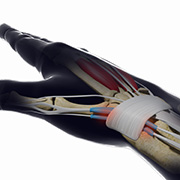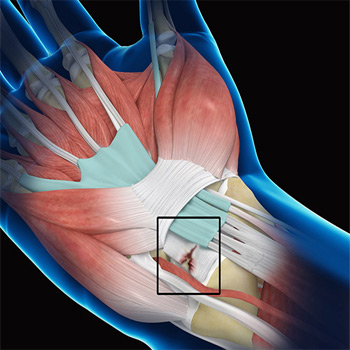- Anatomy
- Conditions
- Procedures
Carpal Instability

Carpal instability is the loss of alignment of the carpal bones and/or radioulnar joint. The wrist is a complex joint that connects the forearm to the hand and allows it to move. It consists of 8 small bones called carpals that articulate with two long bones of the forearm (radius and ulna). The joint is supported by ligaments, tendons, nerves, blood vessels and muscles that help in movement.
Carpal Tunnel Syndrome

Carpal tunnel syndrome is a common, painful, progressive condition that is caused by compression of the median nerve at the wrist area. The common symptoms of carpal tunnel syndrome include numbness and tingling sensation in all the fingers except the little finger, pain and burning sensation in your hand and wrist that may radiate up the arm and elbow, and weakness in your hand with diminished grip strength.
De Quervain's Tendinosis

Inflammation and swelling of the tendon sheaths put pressure on the adjacent nerves and leads to pain and numbness in the thumb side of the wrist. Strain on these tendons can cause swelling and irritation, and lead to a condition called De Quervain's tenosynovitis, which is characterized by inflammation. The condition is also referred to as De Quervain’s tendinitis, De Quervain’s tendinosis, De Quervain’s syndrome or De Quervain’s disease.
Distal Radius Fracture

The forearm consists of two bones, the radius, and ulna. The radius is the larger of the two forearm bones. The region towards the wrist is called the distal end. Fractures in this end are most common.
Dupuytren’s Contracture

Dupuytren’s contracture is a hand condition where thickening of the underlying fibrous tissues of the palm causes the fingers to bend inward. This makes it difficult to fully straighten the affected fingers. It commonly occurs in the ring finger and little finger. Occasionally, the middle finger is affected, but the thumb and index finger are rarely affected.
Hand and Wrist Sports Injuries

Sports injuries are injuries that most commonly occur during sports and exercises. These injuries may result from accidents, poor training practices, use of improper protective gear, lack of conditioning, and insufficient warm-up and stretching. Sports injuries may be either acute (sprains, fractures, tears) or chronic (tendonitis, overuse injury) injuries.
Hand Pain

The hand is composed of nerves, bones, blood vessels, muscles, tendons and skin. Each part has its specific function such as nerves transfer sensation, joints control movements, blood vessels maintain circulation, muscles provide motion, tendons anchor the muscles to the bones, and skin receives sensations.
Wrist Injuries

The wrist is a commonly injured joint in the body. Injuries can occur while lifting and carrying heavy objects, operating machinery, bracing against a fall, or during sports.
Trigger Finger

Inflammation in the tenosynovium leads to a condition called trigger finger, also known as stenosing tenosynovitis or flexor tendonitis, where one of the fingers or thumb of the hand is caught in a bent position. The affected digit may straighten with a quick snap, like pulling and releasing the trigger on a gun, hence the name trigger finger.
Wrist Pain

Wrist pain is defined as any ache or discomfort in the wrist. The wrist is comprised of two bones in the forearm, the radius and ulna, and eight tiny carpal bones in the palm. The bones meet to form multiple large and small joints. A trauma or injury to one or more of these bones results in wrist pain.
Wrist Fracture

The wrist is comprised of two bones in the forearm, the radius and ulna, and eight tiny carpal bones in the palm. The bones meet to form multiple large and small joints. A wrist fracture refers to a break in one or more of these bones.
Flexor Tendon Injuries

Deep cuts on the under surface of the wrist, hand or fingers can cut and injure the tendon, and make it unable to bend one or more joints in a finger. When a tendon gets cut, the cut ends gets pulled away from each other like a rubber band.
Wrist Sprain

Injuries caused due to stretching or tearing of the ligaments in the wrist are called wrist sprains. Sprains can range from mild to severe, based on the extent of injury to the ligament.
Mallet Finger

A mallet finger is a condition where the end of the finger is bent and does not straighten.Mallet finger occurs when the extensor tendon at the back of the finger is damaged.
Finger Sprain

Finger sprains are diagnosed with the help of a physical examination of the hand to check for any abnormalities by moving your fingers in different positions. Your doctor may also suggest imaging tests such as X-rays to determine the exact location of the injury.
Scaphoid Fracture

Scaphoid fracture occurs due to a fall on an outstretched hand with complete weight falling on the palm. This fracture usually occurs during motor accidents or sports activities.
Adult Forearm Fractures

The forearm bones can break in many ways. The bones can crack slightly or can break into many pieces. Forearm fractures are generally due to automobile accidents, direct blow on the forearm or fall on an outstretched arm during sports, climbing stairs, etc.
Arthritis of the Hand and Wrist

Arthritis is an inflammatory condition of the joints. There are several types of arthritis and the most common type is osteoarthritis or wear-and-tear arthritis. Arthritis affects various joints in the body and the arthritis in the hand affects the joint at the base of the thumb. Arthritis may also affect the joints of other digits.
Ganglion Cyst

Ganglion cysts are swellings that most commonly develop along the tendons or joints of wrists or hands. They can be found either at the top of the wrist, palm side of the wrist, end joint of a finger or at the base of a finger.
Arm Pain

Arm pain is a condition characterized by pain, stiffness, or discomfort in any part of the arm. This can affect the hand, wrist, elbow, or shoulder and can have many causes.
Hand Infections

Hand infections, if left untreated or treated improperly, can cause disabilities such as stiffness, contracture, weakness, and loss of tissues (skin, nerve and bone) that will persist even after the infection resolves. Therefore, prompt treatment of hand infections is important.
Sports Injuries of the Hand and Wrist

Sports injuries are injuries that most commonly occur during sports and exercises. These injuries may result from accidents, poor training practices, and use of improper protective gear, lack of conditioning, and insufficient warm-up and stretching.
Wrist Injuries and Conditions

Wrist injuries commonly occur due to falls or certain sports and activities that involve repetitive use or excessive stress or strain on the wrists. These include gymnastics, basketball, working on an assembly line, or typing. Some wrist conditions have no clear cause.
Hand Injuries and Conditions

The hand is made up of the wrist, palm, and fingers and consists of bones, joints, muscles, ligaments, tendons, and many blood vessels and nerves.
Extensor Tendon Injuries

Tendons are bands of tissue connecting muscles to bones. The extensor tendon is a strong, smooth cord that connects finger bones to muscles in the hand. Extensor tendons are located just under the skin, directly on the bone, on the back of the hand and fingers.
Work Related Hand Injuries

The hand is one of the most flexible and useful parts of our body that assist us in most workplace activities. Hand injuries can range from minor cuts or burns to severe injuries.
Fingertip Injuries

A fingertip injury is a wound or damage caused to the most distal portion of the finger. It can be a crush, a sharp cut, a tear or a combination of these, and can result in damage to the skin, nail or nailbed, tendon, pulp, bone, and nerve endings.
Neuromuscular Hand Conditions

Neuromuscular hand conditions refer to disorders of the hands that occur due to an injury or compression of the nerves in the hands or arms that impact the muscles.
Wrist Ligament Tear and Instability

A ligament is a strong, flexible band of fibrous tissue. The wrist has many ligaments that help to keep the wrist bones in proper position providing stability to the joint.
